Tired of watching mariners die, lighthouse keeper started a rescue service
After finding a battered lifeboat washed up on shore from a fatal shipwreck, Joel Munson made it his life's mission to use it to start a life-saving service. Today, his creation soldiers on, as part of the U.S. Coast Guard.
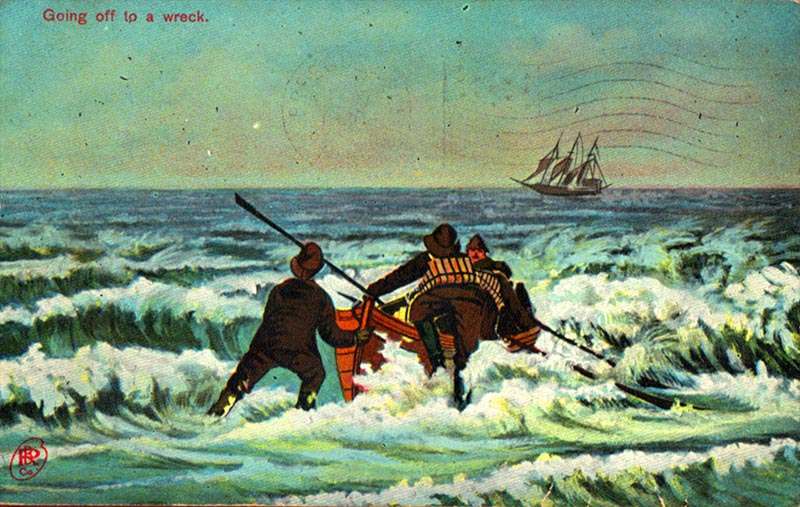
A vintage postcard image, from around the turn of the 20th century,
showing a lifesaving crew launching a surfboat to go to the rescue of a
foundering schooner.
By Finn J.D. John — June 19, 2011
Downloadable audio file (MP3)
It was the Ides of March, 1865. Captain I. Lewis, commander of the 300-ton bark Industry, was staring at the mouth of the Columbia River.
He'd been staring east at that river for two straight weeks, as the Industry tacked back and forth in the safe, deep waters beyond the notorious Columbia River bar, known for good reason as a graveyard of ships. Lewis was waiting for the bar pilots to send a boat with a pilot over to guide the big windjammer safely into the river. But no pilot had come, and now the Industry's supplies of food and water were exhausted. Lewis couldn't wait any longer.
He gave the order to fall off the wind and sail into the bar.
Watching worriedly from shore
At the top of the Cape Disappointment Lighthouse, on the Washington side of the river, the lighthouse keeper, Joel Munson, must have watched this with mounting anxiety. Captain Lewis was taking a huge risk, and no one knew that better than Munson. His duties at the lighthouse went beyond tending the light; it also regularly fell to him to retrieve and arrange for burial of the corpses of unlucky mariners that all too frequently washed up on the beach nearby. The prevailing winds on the Oregon coast come out of the southwest, so when a ship foundered on the bar, the wreckage — human and otherwise — tended to be blown his way.
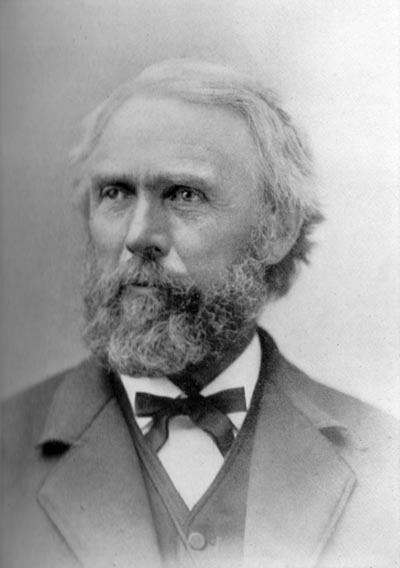
Capt. Joel Munson. This portrait was made in his later years,
probably when he was operating a steamer, circa 1880.
(Image: Joseph Gaston) [Larger image: 1200 x 1703 px]
Sailing ships were especially vulnerable on the bar. There were unpredictable wind shadows, and many a ship would sail on in only to be suddenly becalmed at the worst possible moment.
And that's exactly what happened to the Industry an hour or so later. Although the wind picked back up, the current had shifted her position and on the next attempt to tack, the Industry struck a sandbar, which tore off her rudder.
At the mercy of the breaking sea
Now truly helpless, the Industry wallowed in the bar as the seas got bigger — probably as a result of the tide starting to come in. A lifeboat was launched and promptly capsized. The survivors on the ship climbed into the rigging to escape from the pounding breakers, which soon had the decks cleared of everything, including even the cabins. They waited there all day and all night.
Finally, the next day, the seas were calm enough for the survivors to build rafts from the wreckage and float to shore. One raft made it; the other did not. Seven men lived; 17 died.
By the time the last mariner had drowned, it had been a good 48 hours since the Industry's rudder was stripped off. Munson, who had been unable to do anything but watch helplessly, now had something he could do: Go to the beach and look for corpses.
A lucky find from an unlucky ship
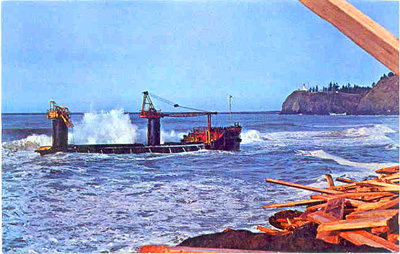
This postcard image shows the wreck of the lumber barge George
Olson, which went aground in the bar in 1964. In the foreground are
some pieces of its cargo, washed ashore from the wreck; in the
background is Cape Disappointment. [Larger image: 900 x 572]
But when he got to the beach, Munson found something else: A battered lifeboat — either the one that had capsized after launch, or one stripped off the Industry by a comber during the break-up.
Munson decided he'd take that lifeboat and use it to actually do something about the situation he found so intolerable.
A one-man fund-raising campign
Munson was a gifted fiddle player — his nickname was "Fiddler Smith." He decided to use that talent, along with his new lifeboat, to get a lifesaving station started at "Cape D." And the next time a ship went down, he'd just row right out there and start rescuing people.
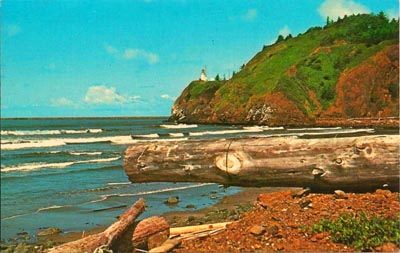
Another postcard image of the Cape Disappointment Light, shot from
the south side — near Peacock Spit. [Larger image: 1200 x 755]
He booked a series of fund-raising dances in Astoria, charging $2.50 a head — equal to about $40 today. The community turned out in force to support the cause. He also talked the lighthouse service into building a boathouse for the lifeboat he was restoring, and put out a call to the community for volunteers to help him row it.
By the following spring, Munson could say with absolute confidence that if the Industry wreck were repeated, every hand would be rescued.
Munson's baptism of fire — or, rather, of seawater

This postcard image shows the distinctive black-striped Cape
Disappointment Lighthouse as seen from the north (Washington) side.
In the foreground is some of the flotsam blown onto the shore there by
the prevailing southwest winds; in Joel Munson's day, this largely
consisted of broken pieces of sailing ships and bodies of their crew
members. [Larger image: 1200 x 737 px]
But he didn't have to boast. In May of 1866, another bark, the W.B. Scranton — ironically owned and captained by the same fellow who owned the Industry, Paul Corno — came to grief on the bar after running ashore. Munson and his volunteers were ready. Several hours later, the entire crew of 13 men was safely on shore.
A few years later, Munson and his team rowed out again to rescue 10 mariners off the rigging of the Architect, a bark that simply filled with water and sank to the bottom with its masts protruding above the waves.
The tradition is passed on
By 1877, Munson was getting a bit too old for this sort of thing, so he handed it off to his volunteers, retired from the lighthouse service and moved to Astoria.
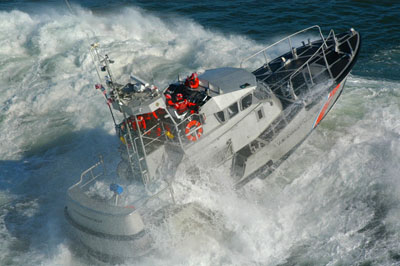
A modern 47-foot motor lifeboat from the Cape Disappointment Life
Station — the one founded by Joel Munson — takes on a big sea off the
Columbia River bar. (Image: U.S. Coast Guard) [Larger image: 1200 x
737 px]
There he built a small steamer, the Magnet, and went into business operating it until 1881, when he was appointed as lightkeeper at Point Adams, on the Oregon side of the river. He did this until 1898, when bad health forced him to leave the post; he died a short time later.
As for the life station he founded, it was staffed by community volunteers until 1882, when the U.S. government made it an official operation and hired career surfmen. An additional station was built at Point Adams. The U.S. Coast Guard runs the stations today, using 47-foot "motor lifeboats" that are virtually unsinkable to rescue mariners in astonishingly hostile seas.
The sacrifice
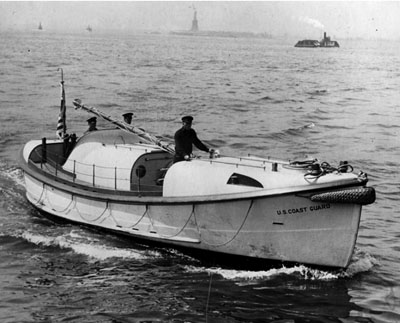
A 36-foot Coast Guard motor lifeboat of the classic Type T, built in the
late 1920s and early 1930s, under way in New York Harbor. (Image:
U.S. Coast Guard)
[Larger image: 1200 x 737 px]
Over the years, thousands of mariners have been saved from the lonely, watery death that came to those 17 sailors on the Industry, almost 150 years ago. And it all started when the Pacific Ocean took away their lifeboat and gave it to Joel Munson.
Nobody wants to drown at sea. Still, if one has to die that way anyway, there's something special and noble about that death being part of something that saves the lives of so many others.
(Sources: Marshall, Don. Oregon Shipwrecks. Portland: Binford & Mort, 1984; Gaston, Joseph. The Centennial History of Oregon, 1811-1912, v. 2. Chicago: S.J. Clark, 1912; DeWire, Elinor. "In Focus: Joel Munson, Rescuer," The Focal Point, v. 5, no. 1, Feb. 2009; www.lighthousefriends.com)
TAGS: #JoelMunson #LighthouseKeeper #RescueService CaptainILewis #BarqueIndustry #GraveyardOfShips #CapeDisappointmentLight #Becalmed #Lifeboat #FiddlerSmith #Astoria #FundraisingDances #WBScranton #PaulCorno #Architect #SSMagnet #PointAdamsLight #USCG #USLifesavingService #ColumbiaRiverBar #COAST #CLATSOPcounty














